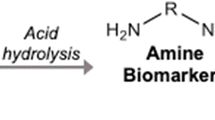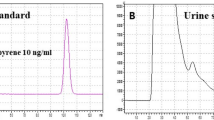Abstract
Objective: To investigate whether methoxyacetic acid (MAA) is the metabolite of ethylene glycol dimethyl ether (EGdiME) in humans and whether its metabolite in urine can be used as a biomarker for exposure to EGdiME. Methods: Workers occupationally exposed to EGdiME, as well as nonexposed controls, were studied. Urine samples were collected from 20 control subjects and, on Friday postshift, from 14 workers. The identification and quantification of the metabolite were performed by gas chromatography/mass spectrometry (GC/MS) and GC/FID, respectively. Air samples were collected on activated charcoal tubes by area sampling with battery-operated pumps. The glycol ether was analyzed by GC/FID. Results: GC/MS clearly showed the metabolite of EGdiME to be MAA. Urinary MAA levels in the control subjects (background levels) were 0.0–0.3 mg/g crea. The levels of urinary MAA in the solvent-exposed workers were significantly (P<0.0001) higher than those in the control subjects. In the eight workers exposed to an average of 0.3 ppm of EGdiME and the six workers exposed to an average of 2.9 ppm, the mean urinary MAA level was 1.08 (range 0.6–1.5) mg/g crea and 9.33 (range 5.7–18.1) mg/g crea, respectively. These results can be explained by differences in the exposure intensity. Conclusions: Our results suggest that MAA is the metabolite of EGdiME, and that MAA in urine may be used for biological monitoring of EGdiME exposures.



Similar content being viewed by others
References
Cheever KL, Richards DE, Weigel WW, Lal JB, Dinsmore AM, Daniel FB (1988) Metabolism of bis(2-methoxyethyl) ether in the adult male rat: evaluation of the principal metabolite as a testicular toxicant. Toxicol Appl Pharmacol 94:150–159
Cook RR, Bodner KM, Kolesar RC, Vanpeenen PFD, Dickson GS, Flanagan K (1982) A cross-sectional study of ethylene glycol monomethyl ether process employees. Arch Environ Health 36:346–351
Cullen MR, Rado T, Waldron JA, Sparer J, Welch LS (1983) Bone marrow injury in lithographers exposed to glycol ethers and organic solvents used in multicolor offset and ultraviolet curing printing processes. Arch Environ Health 38:347–354
Foster PM, Lloyd SC, Blackburn DM (1987) Comparison of the in vivo and in vitro testicular effects produced by methoxy-, ethoxy- and n-butoxy acetic acids in the rat. Toxicology 43:17–30
Hardin BD, Eisenmann CJ (1987) Relative potency of four ethylene glycol ethers for induction of paw malformations in the CD-1 mouse. Teratology 35:321–328
Japan Society for Occupational Health (JSOH) (2004) Recommendation of occupational exposure limits (2004–2005). J Occup Health 46:329–344
Leonhardt DE, Coleman LW, Bradshaw WS (1991) Perinatal toxicity of ethylene glycol dimethyl ether in the rat. Reprod Toxicol 5:157–162
Menke R, Chelton CF (1988) Evaluation of glove material resistance to ethylene glycol dimethyl ether permeation. Am Ind Hyg Assoc J 49:386–389
Rawlings SJ, Shuker DE, Webb M, Brown NA (1985) The teratogenic potential of alkoxy acids in post-implantation rat embryo culture: structure-activity relationships. Toxicol Lett 28:49–58
Sakai T, Araki T, Masuyama Y (1993) Determination of urinary alkoxyacetic acids by a rapid and simple method for biological monitoring of workers exposed to glycol ethers and their acetates. Int Arch Occup Environ health 64:495–498
Shih TS, Liou SH, Chen CY, Chou JS (1999) Correlation between urinary 2-methoxy acetic acid and exposure of 2-methoxy ethanol. Occup Environ Med 56:674–678
Shih TS, Hsieh AT, Liao GD, Chen YH, Liou SH (2000) Haematological and spermatotoxic effects of ethylene glycol monomethyl ether in copper clad laminate factories. Occup Environ Med 57: 348–352
Shih TS, Liou SH, Chen CY, Smith TJ (2001) Urinary 2-methoxy acetic acid accumulation in response to 2-methoxy ethanol exposure. Arch Environ Health 56: 20–24
Shih TS, Hsieh AT, Chen YH, Liao GD, Chen CY, Chou JS, Liou SH (2003) Follow up study of haematological effects in workers exposed to 2-methoxyethanol. Occup Environ Med 60:130–135
Uemura K (1980) The teratogenic effects of ethylene glycol dimethyl ether on mouse. Acta Obstet Gynaecol Jpn 32:113
Welch LS, Cullen MR (1988) Effect of exposure to ethylene glycol ethers on shipyard painters: III. Hematologic effects. Am J Ind Med 14:527–536
Author information
Authors and Affiliations
Corresponding author
Rights and permissions
About this article
Cite this article
Yokota, K., Ikeda, N., Johyama, Y. et al. Urinary methoxyacetic acid as an indicator of occupational exposure to ethylene glycol dimethyl ether. Int Arch Occup Environ Health 78, 650–654 (2005). https://doi.org/10.1007/s00420-005-0014-2
Received:
Accepted:
Published:
Issue Date:
DOI: https://doi.org/10.1007/s00420-005-0014-2




